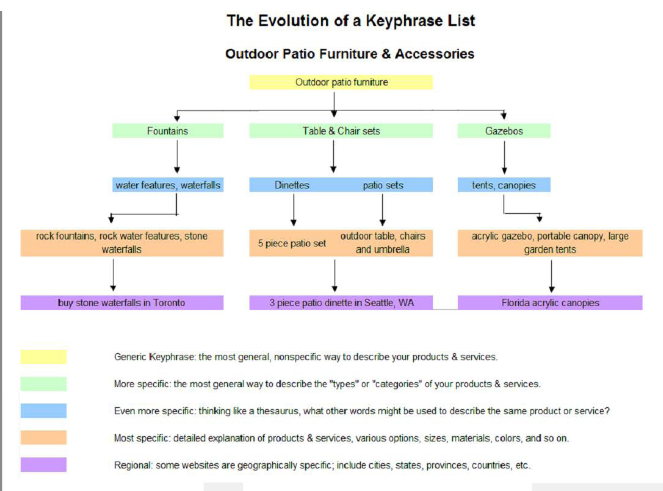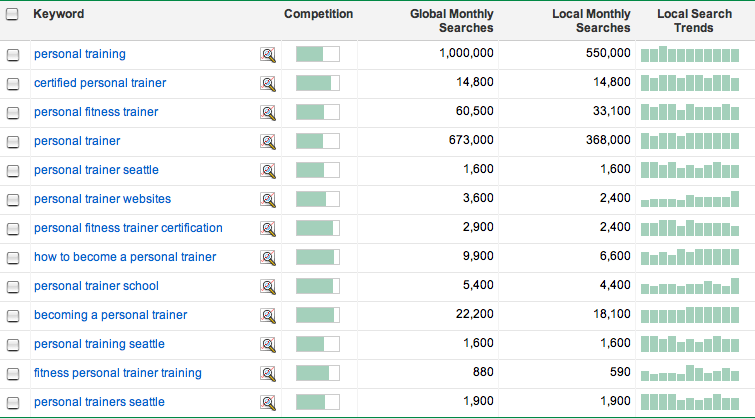How to Create a Page-Level Keyphrase Strategy
 Greetings and congratulations! You’ve done the hard work implicit to a solid, well-researched, SEO copywriting project, and now the rest should come that much easier! You’ve built the foundation: well done!
Greetings and congratulations! You’ve done the hard work implicit to a solid, well-researched, SEO copywriting project, and now the rest should come that much easier! You’ve built the foundation: well done!
Today, we’re going to examine our hard-won, bountiful list of killer keyphrases — and synchronize them with our customer buying cycle to produce a powerful one-two punch to convert our site visitors! Sound good? Allrighty then, let’s get to it!
As you recall, your keyphrases should correspond to your prospects’ buying cycle: the home page content reflecting the most general, overarching keyphrases, and the sales/purchase pages containing the specifics: product make, model, features, and possibly (e-commerce) prices. Whenever and wherever possible, your content should stress your Unique Selling Proposition (U.S.P.) and highlight your product/service benefits!
So onto organizing your per-page keyphrase strategy: first, let’s take a step back and get a overall view of the flow and evolution of a keyphrase list (and what a keyphrase list might look like) using the example of an outdoor patio furniture store:
Notice how the phrases get more specific as you move from top to bottom? Whether you have a ten-page website or 10,000 pages, your website should be structured in the same hierarchical way. When every page is carefully crafted for search engine optimization, and you’ve a smart keyphrase strategy in place, you’ve the opportunity to gain positions at all phases of your prospects’ buy cycle!
The key to developing a per-page keyphrase optimization strategy? Simple: segment your keyphrases, choose those keyphrases that match a page’s theme and intent, and use those terms in your writing, titles, and meta-descriptions. Yes, it is that easy, yet most businesses don’t take this step! They randomly insert (or worse, stuff) keyphrases throughout their site, with no strategy in mind. This is precisely why your smart keyphrase strategy will win out!
Organizing your keyphrase seed list for per-page optimization
Now let’s review your initial keyphrase seed list. Depending on the size of your site, your keyphrase seed list may contain hundreds — if not thousands — of different keyphrases. Envision this: each one of those keyphrases represents a new way for your customers to find you! Pretty cool, yes?
Returning to your Excel document (or legal pad), we’re going to work on the other “tabs” of your keyphrase workbook. What you want to do here is segment your keyphrases by the type of keyphrase it is:
- Awareness keyphrases These are the general, overarching keyphrases that describe in the most general terms what it is you offer. Typically, these keyphrases should be placed on your home and subcategory pages.
- Brand keyphrases If you’re a larger company or otherwise widely recognized, then your prospects are highly familiar with your brand (think Hilton, Brookstone, See’s Candies). Brand keyphrases are keyphrases that include your company’s brand name.
- Category keyphrases Many general “awareness” keyphrases do double-duty as category keyphrases. For instance, if you are selling electronics, a category page may specifically focus on “digital cameras” — and you’d have product links and informative reviews linking from this page.
- Subcategory keyphrases Major sections of a main category are composed of subcategory keyphrases. For instance, if you owned an online clothing store, women’s leather jackets would be a subcategory.
- Seasonal keyphrases Remember the seasonality/social buzz/trends check you did while compiling your initial keyphrase seed list? If you’ve any keyphrases that are seasonal due to the holidays (like men’s clothing via Google Insights), events, or buzzed-up popularity (like the snap leather bracelets “being the new black” chat on Twitter), they would go on this tab’s list.
- Product/Service keyphrases Product-and service-level keyphrases are highly specific, relating directly to a product or service. For instance, using our digital cameras example, the product page would be optimized for specific camera models and their respective features/benefits.
- Research keyphrases There is virtual plethora of keyphrases that people search under when they know they want to buy something, or employ a service, or work with someone — but they haven’t yet settled on what or whom. They’re in the critical research phase of the buy cycle, where they’re investigating resources and exploring their options.
So how do we capture our prospects in this crucial phase of the buy cycle?
As an example, let’s look at the keyphrase research for a personal fitness trainer in Seattle, WA:
Here you will find a great source of keyphrases that could be used in content marketing, such as informative articles, reviews, and blog posts. For instance, article titles could include:
- Five benefits of personal training
- How to choose the right personal fitness trainer for you
- The top 10 best personal trainers in Seattle
Simply go through your initial seed list and include each keyphrase on the tab (or tabs — yes, a keyphrase can be on more than one tab) where it belongs. Once your keyphrase workbook is complete, you’ll have a quick-scan way to see your keyphrases and match them to your site pages.
Although this step may be time-consuming, it’s a great way to track your current keyphrase list and see how your keyphrases are segmented across the various “types” of phrases: awareness, research, purchases, and their respective, keyphrase-segmented categories. What’s more, it makes your final keyphrase research step incredibly easy!
So stay tuned! Next week we will strategize our per-page keyphrase choices! You’re well on your way to producing killer SEO copywriting and content!



Great Content Heather! Do you mind if I use this as a guideline? I am just wondering why you are giving so much valuable information. I would expect to find this in your course, I can only imagine how comprhensive your certification program must be. Thanks for sharing!
Hello!
Thanks for your kind comment! And yes, there are all sorts of tasty SEO copywriting tips, tidbits and strategies in the training. It’s VERY comprehensive (and fun, too!) :D